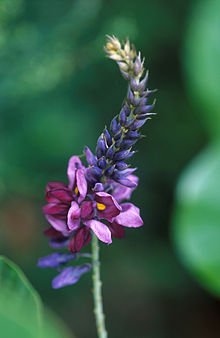Invasive Species: Kudzu
The kudzu vine (Peuraria montana) is a deciduous perennial that grows rapidly to cover barns, road signs, fields, cars, trees, and houses. It grows up to a foot a day and 60 feet in a season. It dies back with the first frost and begins growing from the die back-point.
Kudzu stems can reach 4 inches in diameter and are spongy or rubbery in texture rather than woody. The bark's smooth with white pits. When cut, the stem gives off a menthol scent.
Kudzu leaves are compound, have a hairy margin, and have up to three leaflets. The leaflets are 2.5 to 11 inches in length and up to 4 inches across. It flowers in July, and blossoms are usually a medium to dark purple, however, white and lilac flowers are also found. The flowers give off a sweet scent, and in September, the plant forms pea-like pods.

Kudzu: From Prized Garden Species to Weed
Kudzu is a native of Eastern Asia and was introduced to the United States in 1876 at the Centennial Exposition in Philadelphia, PA. American gardeners fell in love with the plant's ornamental uses, and farmers liked its potential as animal fodder. I,n the Great Depression, over 8.5 million seedlings were planted planted for erosion control along highways and on hillsides by the Soil Conservation Service.
In 1953, the US Government stopped advocating the use of kudzu, and in 1972, it was declared a weed.
Kudzu has been found as far north as Ontario, Canada and is established in several Northern states, such as New York, Pennsylvania, and North Dakota. It has been seen in Michigan and Ohio.
Control of Kudzu
There is no simple way to control kudzu, especially since its insect predators were not introduced with it.
With seedlings or resprouting vines, the leaves and stem should be cut, the vine dug, and the tap root cut. Poison (Glyphosate or Triclopyr) can be applied to the root. Repeated cuttings at two-week intervals can also be used to control seedlings.
Mature plants with their deep taproots cannot be dug, so the stump cut method can be used. First, the foliage is removed, burned or bagged, and the stump cut. Next, poison is applied to the cut stump immediately.
For large areas overtaken by kudzu, the foliage should be sprayed with poison, followed by the stump cut method. It's helpful to trim the vines to avoid damaging non-kudzu plants.
Uses of Kudzu
Farmers use kudzu as fodder and bale it into hay. Others raise goats or cows on kudzu pastures. Kudzu is also used for basket weaving, in cooking, and as a herbal medicine. Studies have found that an extract from kudzu is helpful in controlling alcohol addiction.
References
Shore, Max. The Amazing Story of Kudzu.